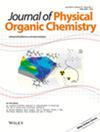5-氯尿嘧啶催化的质子转移理论研究
IF 1.9
4区 化学
Q2 CHEMISTRY, ORGANIC
引用次数: 0
摘要
本研究采用密度泛函 M06-2X/6-311++G(3df,3pd)方法研究了在水、甲醇、甲酸和电场催化下,5-氯尿嘧啶由二酮到二醇的相互异构化反应机理。得到了反应焓、活化能、活化吉布斯自由能和质子转移反应速率等参数。计算结果表明,在相同条件下,甲酸的催化效果最好,而电场催化对反应壁垒的影响最小。本文章由计算机程序翻译,如有差异,请以英文原文为准。
Proton transfer theoretical study catalyzed by 5-chlorouracil
In this study, the density functional M06-2X/6-311++G(3df,3pd) method was employed to investigate the mutual isomerization reaction mechanism of 5-chlorouracil from diketone to diol under the catalysis of water, methanol, formic acid, and an electric field. Parameters such as reaction enthalpy, activation energy, activation Gibbs free energy, and proton transfer reaction rate were obtained. The computational results show that under the same conditions, formic acid demonstrates the best catalytic effect, while the influence of electric field catalysis on the reaction barrier is minimal.
求助全文
通过发布文献求助,成功后即可免费获取论文全文。
去求助
来源期刊
CiteScore
3.60
自引率
11.10%
发文量
161
审稿时长
2.3 months
期刊介绍:
The Journal of Physical Organic Chemistry is the foremost international journal devoted to the relationship between molecular structure and chemical reactivity in organic systems. It publishes Research Articles, Reviews and Mini Reviews based on research striving to understand the principles governing chemical structures in relation to activity and transformation with physical and mathematical rigor, using results derived from experimental and computational methods. Physical Organic Chemistry is a central and fundamental field with multiple applications in fields such as molecular recognition, supramolecular chemistry, catalysis, photochemistry, biological and material sciences, nanotechnology and surface science.

 求助内容:
求助内容: 应助结果提醒方式:
应助结果提醒方式:


